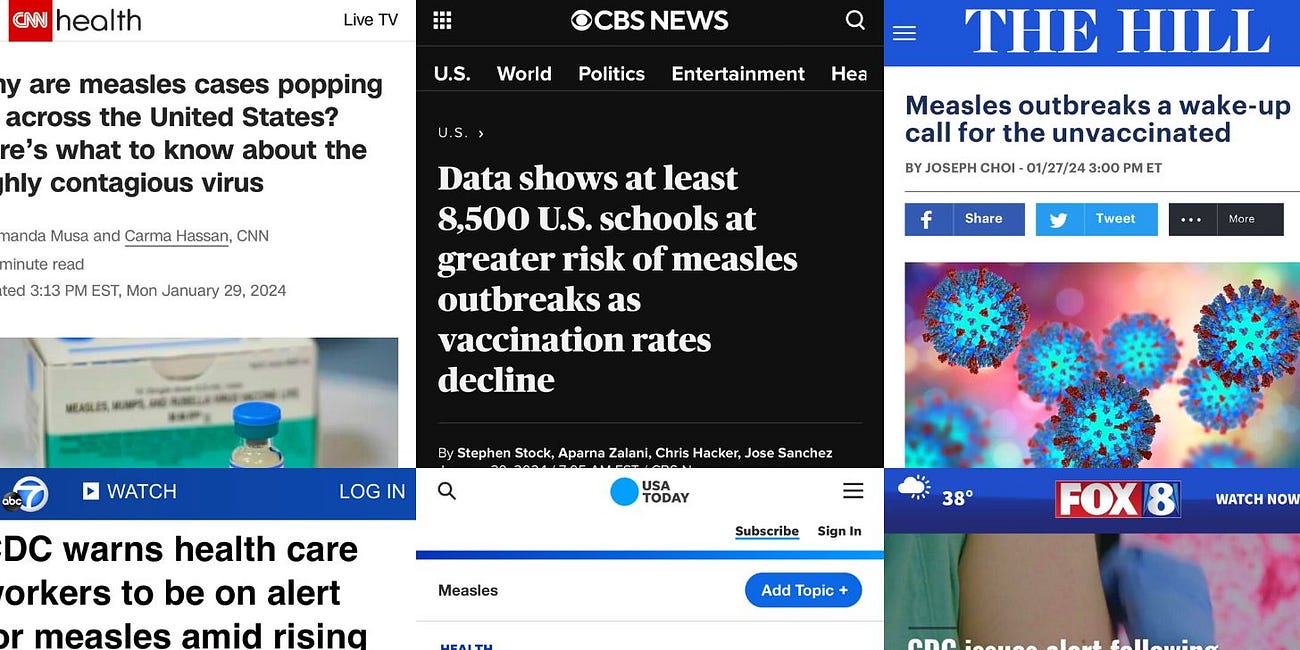U.S. Measles Outbreaks Follow MMR Vaccination Campaign
MMR vaccine contains "live" measles virus, according to FDA package insert.
America might be “on the precipice of a major measles outbreak,” according to mainstream news reports.
Follow Jon Fleetwood on Instagram @realjonfleetwood / Twitter @JonMFleetwood
“Hundreds of people are already feared to be infected in California and Arizona after cases were confirmed in people in the states who visited local hospitals.”
Cases in the first two months of 2024 have nearly outpaced the whole of last year.
“A total of 45 measles cases were recorded in the US over the first two months of 2024 across 17 states,” which is “near the tally of 58 infections recorded in the whole of 2023.”
However, more than nine in 10 U.S. children and teens have received an MMR (Measles, Mumps, and Rubella) vaccine, according to the Centers for Disease Control and Prevention (CDC).
In fact, a 2022 study in the peer-reviewed journal Vaccine characterizes the measles vaccination rate in the U.S. as “high.”
“Measles vaccine coverage in the US is high: 90.8% of children received at least one measles, mumps, and rubella (MMR) vaccine by 24 months old,” the study authors confirm. “Due to high vaccine coverage, in 2000, the World Health Organization (WHO) declared measles eliminated from the United States (US).”
The mainstream health and media industries began pushing MMR vaccination on the public late last year.
After maintaining a “high” vaccination rate among Americans, the country now faces measles outbreaks, raising questions about the vaccine’s efficacy and even its potential to cause the disease.
Follow Jon Fleetwood on Instagram @realjonfleetwood / Twitter @JonMFleetwood
MMR Vaccine Contains ‘Live’ Viruses
The Food and Drug Administration’s (FDA) package insert for the MMR vaccine indicates the drug contains “live” measles, mumps, and rubella viruses.
The insert states that “each approximately 0.5-mL dose contains not less than 3.4 log10 Cell Culture Infective Dose 50% (CCID50) of measles virus, 4.2 log10 CCID50 of mumps virus, and 3.3 log10 CCID50 of rubella virus.”
Because the vaccine contains live measles viruses, individuals have contracted “measles-like illness associated with vaccination,” according to a 2016 Vaccine publication.
That study confirmed a report of a “vaccinated healthy adult exhibiting classic measles-like symptoms beginning 18 days post-vaccination.”
Likewise, a 2014 letter published in The American Journal of Medicine affirmed that “[v]accine-associated measles can occur in [vaccinated] children.”
Moreover, a 2017 case report published in the Dutch journal The Nederlands Tijdschrift voor Geneeskunde (NTvG), the main medical journal in the Netherlands, documented that “a 14-month-old boy was admitted to the hospital with an impressive rash 13 days after MMR-vaccination.”
The report authors stated that the case “strongly suggests that these symptoms will likely be a reaction to vaccination.”
Follow Jon Fleetwood on Instagram @realjonfleetwood / Twitter @JonMFleetwood
Do MMR-Vaccinated ‘Shed’ Measles Onto Others?
In addition to potentially causing measles symptoms, the MMR vaccine is associated with ‘shedding,’ whereby an individual “releases, or sheds, the components of a vaccine either inside or outside of their body.”
Although shedding doesn’t always pass the virus to others, it’s still a possibility.
An April 2012 publication in the peer-reviewed journal Paediatrics & Child Health explains how a vaccinated child was examined after developing a new-onset measles-type rash.
Nucleic acid testing confirmed that a “vaccine-type measles virus was being shed in the [child’s] urine,” meaning he could have passed the virus onto others.
Follow Jon Fleetwood on Instagram @realjonfleetwood / Twitter @JonMFleetwood
Rising Worldwide Cases of Measles, Which Pfizer's Safety Data Links to COVID-19 Vaccine
The U.S. Centers for Disease Control and Prevention (CDC) and mainstream news are reporting an increase in measles cases around the United States.





